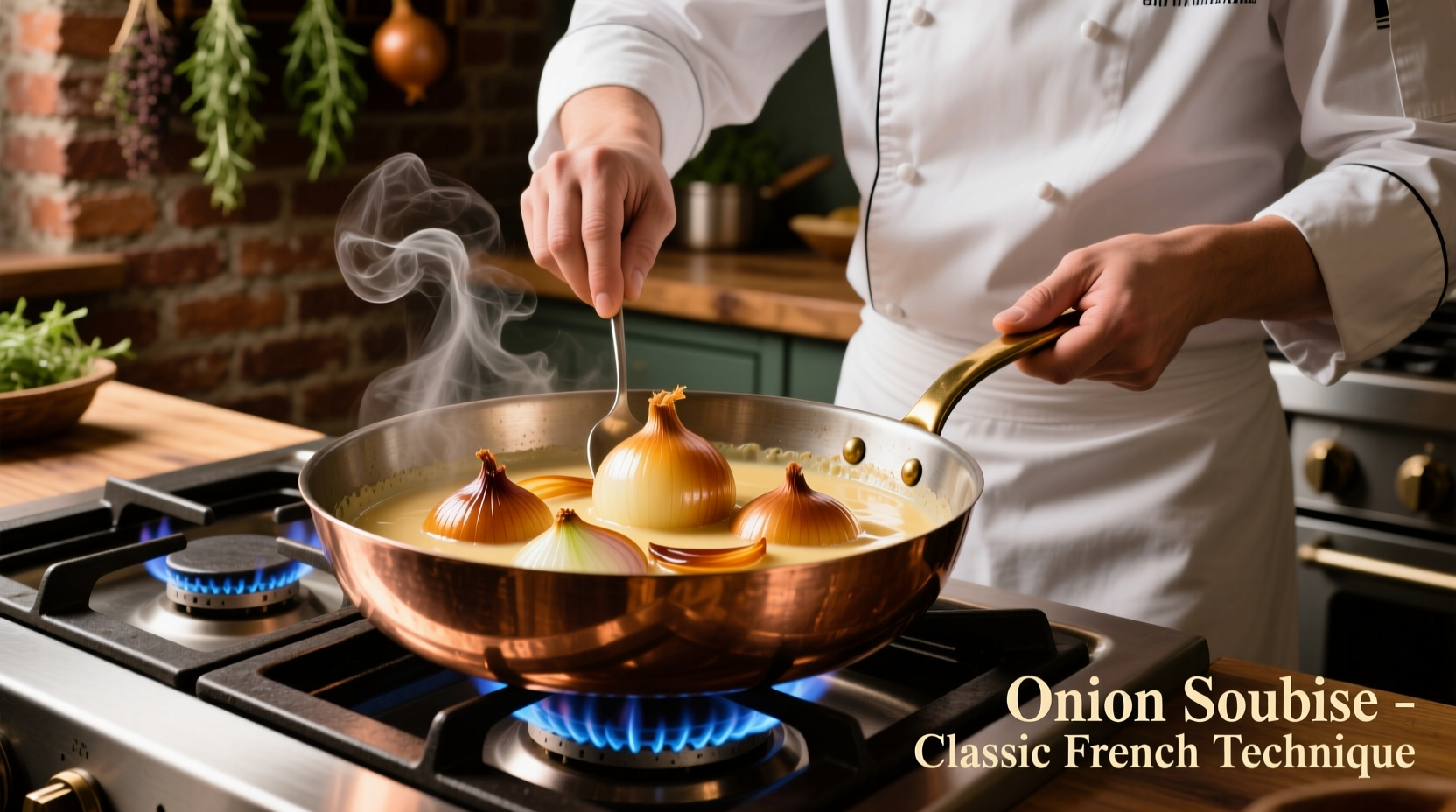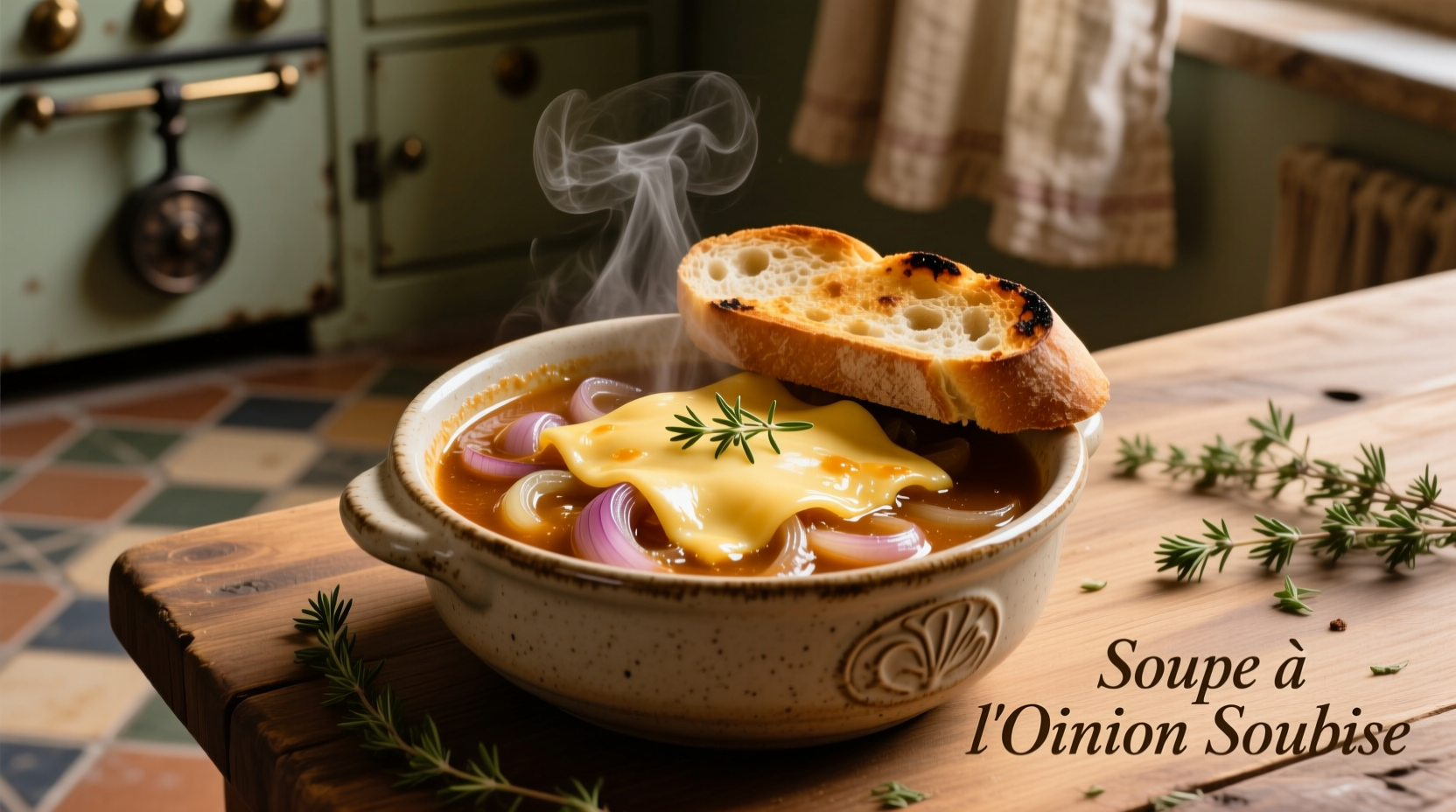Onion soubise is a classic French sauce made by slowly caramelizing onions until sweet and tender, then blending them with béchamel or cream for a smooth, velvety texture. Unlike regular onion sauces, soubise contains no stock and relies on the natural sweetness of slowly cooked onions, making it perfect for pairing with roasted meats, poultry, and delicate fish dishes.
What Makes Soubise Different From Ordinary Onion Sauce
Many home cooks confuse onion soubise with standard onion gravy or sauce, but the French preparation follows specific culinary principles that create a distinctive flavor profile. The key difference lies in the cooking technique and ingredient proportions. While traditional onion sauces often incorporate stock or wine for depth, authentic soubise builds flavor solely through the careful caramelization of onions.
| Characteristic | Onion Soubise | Standard Onion Sauce |
|---|---|---|
| Liquid Base | Cream or béchamel | Stock, wine, or water |
| Cooking Time | 45-60 minutes slow caramelization | 15-25 minutes |
| Sweetness Level | Naturally sweet from caramelized onions | Often requires added sugar |
| Texture | Smooth, velvety puree | Can be chunky or coarse |
| Traditional Pairings | Lamb, poultry, veal | Beef, burgers, sandwiches |
The Historical Evolution of Onion Soubise
Understanding the timeline of onion soubise reveals why this sauce remains relevant in modern kitchens. The sauce's origins trace back to 17th century France, named after the Duke of Soubise who popularized this preparation method among French aristocracy.
- 1650s - First documented references appear in French culinary manuscripts
- 1820s - Included in Marie-Antoine Carême's foundational culinary texts
- 1903 - Auguste Escoffier standardizes the recipe in Le Guide Culinaire
- 1970s - American chefs like Julia Child introduce simplified versions to home cooks
- Present Day - Modern interpretations incorporate regional ingredients while maintaining core technique
Perfecting Your Onion Soubise: Step-by-Step Guide
Creating authentic onion soubise requires patience and attention to detail. The secret lies in the slow cooking process that develops complex flavors without burning the onions. Professional chefs consistently emphasize that rushing this stage compromises the final result.
Essential Ingredients
- 1.5 pounds yellow onions (about 3 medium), thinly sliced
- 3 tablespoons unsalted butter
- 1/4 cup heavy cream or béchamel sauce
- Pinch of nutmeg (optional)
- Salt to taste
Critical Cooking Technique
- Slice onions uniformly - Consistent 1/8-inch slices ensure even cooking
- Low and slow caramelization - Cook over medium-low heat for 45-60 minutes, stirring occasionally
- Monitor color development - Target a deep golden brown, not blackened
- Add cream gradually - Incorporate after onions are fully caramelized
- Blend to smooth consistency - Use immersion blender for best texture

When Onion Soubise Works Best (And When to Choose Alternatives)
Understanding context boundaries helps you determine when onion soubise enhances a dish versus when another preparation might serve better. This knowledge separates competent cooks from truly skilled ones.
Ideal Applications
- Accompaniment to roasted chicken or turkey
- Base for poached fish dishes
- Component in refined vegetarian entrees
- Enhancement for delicate veal preparations
Situations Where Alternatives Work Better
- When pairing with strongly flavored red meats (consider red wine reduction instead)
- For quick weeknight meals (regular onion sauce requires less time)
- When serving guests with dairy restrictions (substitute coconut milk for cream)
- With very spicy dishes that would overwhelm the subtle onion flavor
Common Mistakes That Ruin Onion Soubise
Based on culinary school teaching experience, certain errors consistently undermine this delicate sauce. Avoid these pitfalls to achieve restaurant-quality results at home:
- Rushing the caramelization process - High heat burns onions before they develop proper sweetness
- Using the wrong onion variety - Red onions add unwanted color; sweet onions lack necessary structure
- Adding liquid too early - Prevents proper Maillard reaction from developing
- Over-blending - Creates a gluey texture rather than smooth velvety consistency
- Seasoning at the wrong time - Salt too early draws out moisture and steams rather than caramelizes
Modern Variations Worth Trying
While purists might scoff, thoughtful adaptations can expand your culinary repertoire. The key is maintaining the fundamental technique while thoughtfully incorporating new elements:
- Shallot Soubise - Substitute half the onions with shallots for more complex flavor
- Herb-Infused - Add thyme or tarragon during the final minutes of cooking
- Roasted Garlic Soubise - Blend in 2-3 roasted garlic cloves for depth
- White Wine Variation - Deglaze pan with 1/4 cup dry white wine after caramelizing
Why Professional Kitchens Keep Soubise in Rotation
Despite its simplicity, onion soubise remains a staple in professional kitchens for compelling reasons. According to culinary research from the Culinary Institute of America, chefs value soubise for its versatility and ability to elevate dishes without overpowering primary ingredients. The sauce's gentle sweetness complements proteins without competing with their natural flavors, making it particularly valuable for fine dining establishments focused on ingredient purity.
Unlike many modern sauce trends that come and go, soubise has maintained relevance because it solves a fundamental culinary challenge: how to add richness and complexity without heaviness. This balance explains why contemporary chefs continue to feature soubise in seasonal menus, often with creative regional twists while honoring the classic technique.











 浙公网安备
33010002000092号
浙公网安备
33010002000092号 浙B2-20120091-4
浙B2-20120091-4